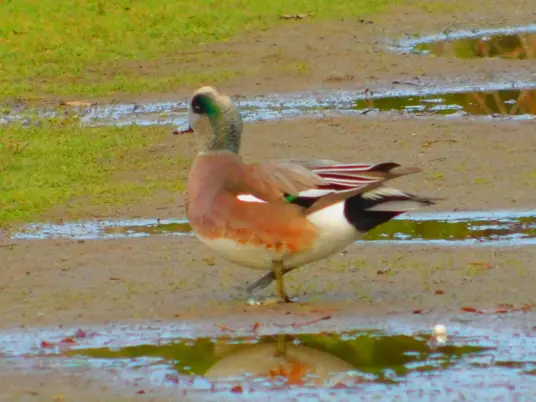A Trip of Wigeons
by Marcia Wilson
Fall Residents
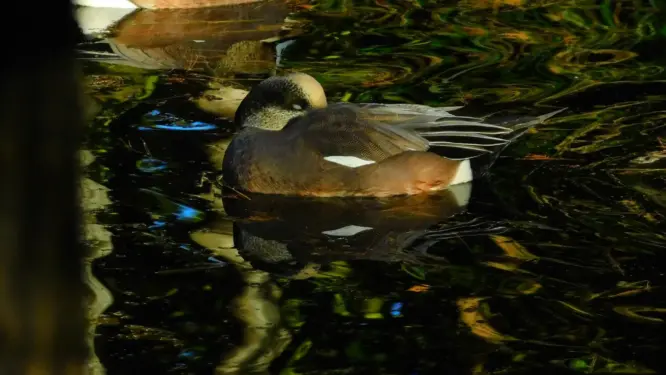
The Fall Equinox came on September 22, and with perfect timing, the American Wigeons returned to the CPTC wetlands. While a group of ducks are called flocks, a group of wigeons are called a trip.
Indicator Species Indicate What?
Wigeons, a small dabbling (shallow water-feeding) duck are an indicator species for the South Puget Sound.
“An indicator species is an organism whose presence, absence or abundance reflects a specific environmental condition. Indicator species can signal a change in the biological condition of a particular ecosystem, and thus may be used as a proxy to diagnose the health of an ecosystem.” –from The University of Puget Sound
Wigeons mean the site has a lot of plant food, often in a mixture of wetland and dryland conditions. They feed heavily in large, social groups on dry land and forage in a large variety of waters from shallow to deep, fresh to brackish.
Wigeons depend almost completely on a vegetarian/seaweed diet. They eat a lot between migratory hops and persicarias and milfoil are just a few of their dining options.
American Wigeons
Although wigeons are gorgeous, their colors are difficult to describe. Are their bills gray, white, or baby blue? Are their pale forecheeks and pates white, cream, or yellow? Is the Eurasian Widgeon’s head a chestnut color, or a red? Is the crown gold or orange? American wigeons are the most seen and they can be very striking in the sunlight with the male’s bottle-green heads with creamy crowns.
The Eurasian Widgeon
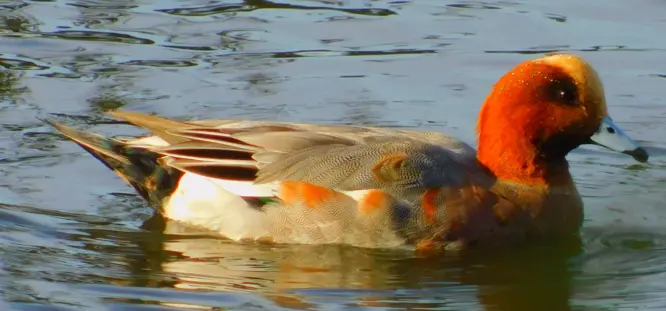
The Eurasian Widgeon (always check for the letter d) is always a treat. Their normal ranges are the Eastern shores of Russia and Asia. Heavy weather events are responsible for any seen in Washington State. They stand apart from the Americans from their striking brick red heads with a lemony-white crown. The best chance to see one is through the American Wigeons; they like each other’s company. Three pairs live by the Narrows Bridge. A male Eursasian was seen in 2018 dabbling in the college wetlands by an inexperienced birder who did not make a report.
A birder discovered a hybrid American/Eurasian wigeon in Kent back in 2004. With its green cheeks and a cream crown on a ruddy head, it was a colorful blend of both worlds.
Whistle up a Storm: The Storm Wigeon
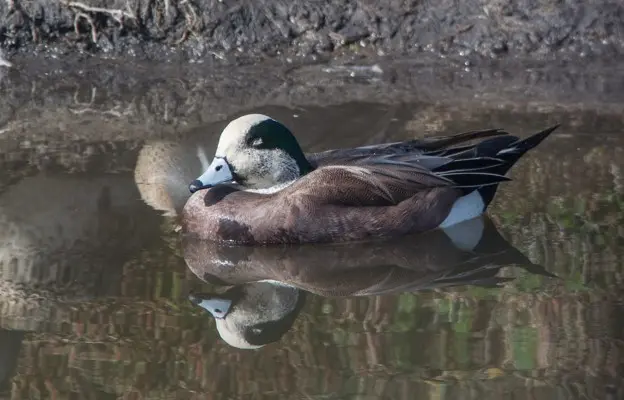
The Storm Wigeon, or, “the White-Cheeked Wigeon,” is a rare color morph thanks to recessive genes that show up about 1:500 birds. West-Coasters associate their arrival with heavy storms from the north. To see one is to delight Pacific Coast birders. The odds of seeing one are about 1:500.
Wigeons are not restricted to freshwater or brackish estuary water and gather to feed in large flocks within the Chambers Creek Watershed. The Flett is the largest waterbody within this range and portions of the wetlands will see large flocks of these small ducks settling in for a few days of winter rest and recreation. Often their calls give them away. In summer a few will retreat deep into the cattails, far from casual viewers and they build strange-looking nests that look like collapsed wicker baskets.
Lovely Paraducks
Wigeons have made a few evolutionary changes in their physiology and their behaviors because they happen to do things differently from other ducks.
Wigeons are odd ducks, literally, because even though they are aquatic waterfowl, they spend most of their lives grazing on land.
Physiology: Wigeons evolved an unusually short, pointed bill more like a goose than a typical duck. The shape and size make the bill a tool for pinching up bulbs, nutlets, and rhizomes with the precision of chopsticks, plus the strength to grip and pull. This is ideal for ripping up tough underwater plants, or clover and field grain.
Evolutionary Behavior
For a dabbling duck, the wigeon spends a great deal of time outside of shallows. This is because they want the plants beneath the water, but they can’t dive deeply enough to reach them. The solution is a life of crime. After a diving duck collects plants, it breaks to surface where the wigeon is waiting to grab and run. This is called kleptoparasitic behavior. It is actually risky. As one researcher for Muhlenberg College summarizes, “you can get yourself bashed.”
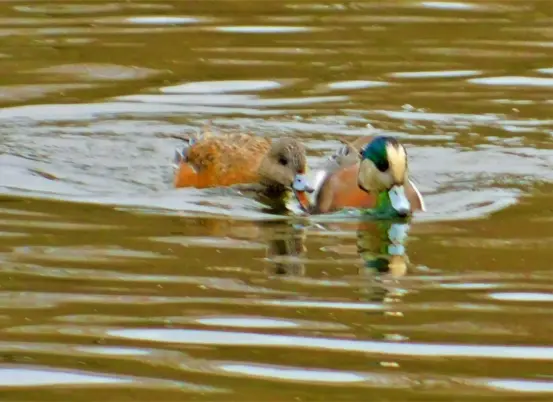
Criminals Act Guilty
Wigeons are skittish; they take flight with random patterns to confuse predators. Their inability to “make friends” with their thieving does little to help their social standing with other birds. If startled–and this happens easily–they explode from ground into the air, whistling like a large collection of airborne kazoos. This “silly behavior” is why in older North American slang to call someone a widgeon is to say they are being foolish.
Foolish or not, wigeons are unique and managing to hold their own in the face of diminishing wetlands across the country. They are beautiful, unique, and a reliable winter resident to the CPTC marsh.
